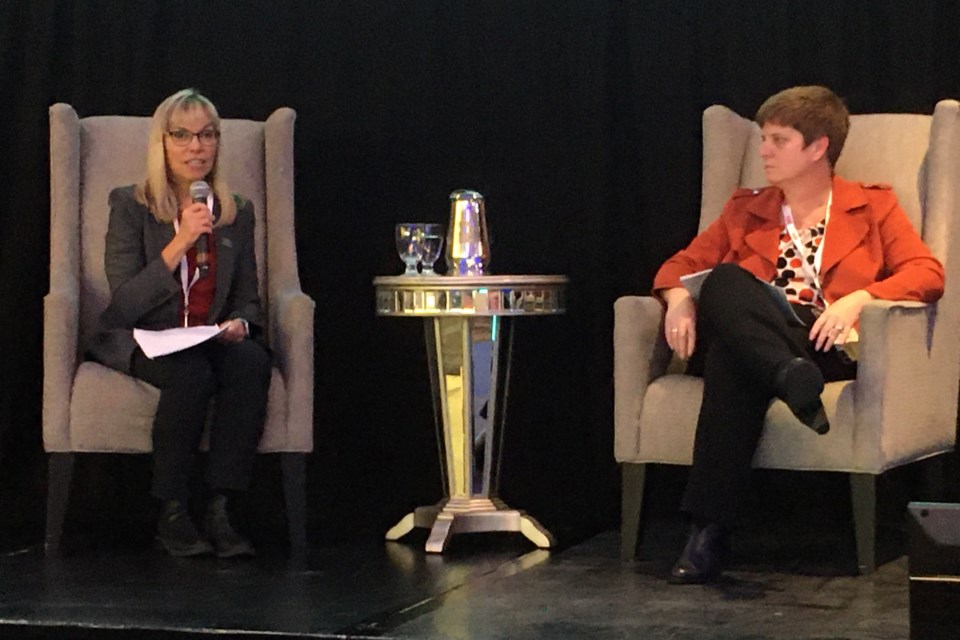It may be a year or more before the first electric bus comes to Burlington streets, but that didn’t stop more than 200 experts, suppliers, academics and municipal officials from coming to town Oct. 17 and 18 to discuss Zero Emission Transit and the electrification of transit fleets.
They came from across Canada to attend the fifth annual Canadian Urban Transit Research & Innovation Consortium (CUTRIC) conference.
CUTRIC is a non-profit organization that spearheads, designs, and launches technology and commercialization projects that advance next-generation zero-carbon mobility and transportation solutions across Canada. The two-day event at the Burlington Convention Centre was opened by Mayor Marianne Meed Ward, who
spoke of her use of transit and recent developments to Burlington Transit such as free rides for seniors and youth.
“We know that there is a relationship between free fares and ridership.” said Meed Ward. “That just shows that the more you can do to reduce those barriers, the more you can get people on the bus and that makes it better for all people.”
Presentations and panel discussions at the conference focused on topics such as Overcoming Supply Chain Issues, Electric Bus Charging Infrastructure, Hydrogen Fuel Cell Buses, Unlocking Government Funding and more.
Catherine Baldelli, director of Burlington Transit, was on a panel to discuss how smaller transit fleets can transition to electrification. Burlington has a fleet of 79 conventional and specialized buses, compared to Toronto with over 2,000 buses and 1,000 streetcars. Winnipeg has 640 buses.
“Our journey towards zero emissions began a few years ago,” Baldelli explained to the crowd. “Burlington engaged CUTRIC to help Burlington have a better understanding of what fleet electrification would look like.
“The study included details about technology using battery electric buses and battery charging infrastructure. CUTRIC examined our routes, our transit schedules, traffic impediments, speed limits, and topography. This helped us understand the number of buses we would need to provide existing coverage and future expansion.”
Baldelli also shared some “lessons learned” through Burlington Transit’s planning stage.
“All major projects take time, so start now," she said. "Preparing for specifications, procurement, bus orders and delivery is not an overnight project. Engage your local hydro company because we don’t know how much power we’re going to need. Training will be important for all staff – maintenance, operating, planning and customer service. It’s also important to have a long term financial plan.”
Burlington Transit, in conjunction with London Transit and working in partnership with CUTRIC, is part of a joint procurement arrangement to purchase four electric buses in a pilot program for Burlington and 10 for London. Kelly Paleczny, general manager of London Transit (223 buses) was also on the panel describing how the mayor of London suddenly announced in 2020 that the city would be the first in Canada to have an all-electric fleet – much to the surprise of those at London Transit.
The takeaway, according to Paleczny, was to keep in communication with municipal leaders and start planning today for what seems inevitable. However, Paleczny also cautioned that transit systems should not ignore services such as ease of use, connectivity, and ridership growth while transitioning the fleet to electric or hybrid buses.
A panel on “The Synergy between Regulated Utilities and Service Providers” highlighted the importance for large energy consumers, such as a transit system going all-electric, to plan far in advance and work in conjunction with the local utility to avoid delays.
It was noted that, for some utilities, the introduction of an all-electric fleet might be one of the biggest consumers of electricity for that utility. Large consumers, unlike residences, must make arrangements through third parties to install and maintain their power consumption infrastructure.
CUTRIC President and CEO Josipa Petrunic told BurlingtonToday.com that a presentation will be made to Burlington City Council in December and that preparations for the purchase of four battery electric buses are around the corner.
“We’re now in the requests for proposal stage for Burlington Transit and the utility (Burlington Hydro) to make sure that as we go out with the final procurement specifications for the first four buses they match not only that the model will work but also what the market says is available.”
Again and again what was heard at the Zero Emission Transit and Mobility conference was that there are a lot of moving parts to achieving zero-emission fleets, but with like-minded partnerships, knowledge sharing among transit systems and the many other players at the table, it is doable.



